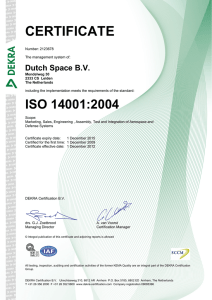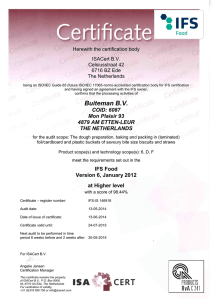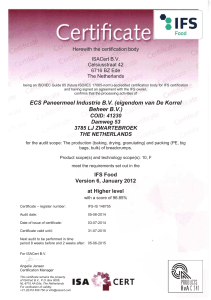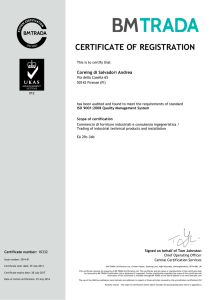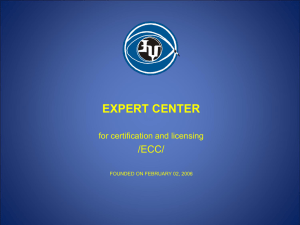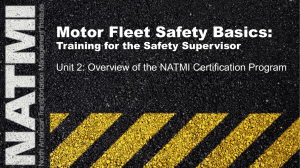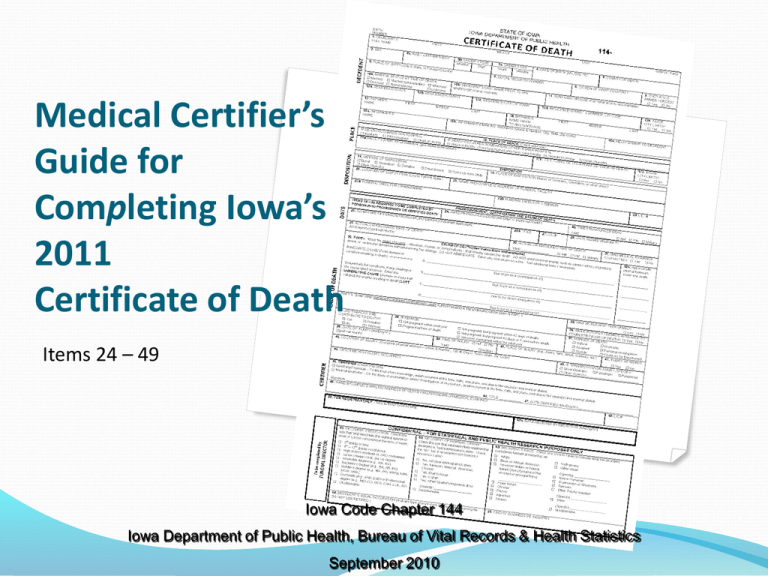
Medical Certifier’s
Guide for
Completing Iowa’s
2011
Certificate of Death
Items 24 – 49
Iowa Code Chapter 144
Iowa Department of Public Health, Bureau of Vital Records & Health Statistics
September 2010
Development of the Revised Death
Certificate 11th Revision
The U.S. Standard Certificate of Death had 10 revisions during the
20th century.
The revision process begins with a consensus from the States that
a revision is needed. In 1998, the National Center for Health
Statistics (NCHS), Centers for Disease Control and Prevention
(CDC) assembled an expert panel to evaluate the current certificate
and recommend changes.
NCHS issued the specifications in 2003 for the latest revision.
Development of the Revised Death
Certificate 11th Revision
Iowa’s 2011 revision of the Certificate of
Death is a reflection of the national standard
developed by NCHS, as required by Iowa
Code section 144.12 Forms Uniform.
• For U.S. standards, see
www.cdc.gov/nchs/nvss/vital_certificate_revisions
The Data
Collection Form
Only the form prescribed by the
State Registrar may be used
(144.12).
Effective with January 1, 2011,
the 2011 Certificate of Death
shall be used. According to
national standards, 0000
(midnight) is the beginning of
the new day.
Purpose of Death Certificate
-- our final word
The Certificate of Death is a permanent legal
record that provides personal information about
the decedent, the circumstances and cause of
death, and final disposition. For survivors, it is
needed to apply for insurance benefits, settle
pension claims, transfer title of real and personal
property, document the cause of death, and help
provide a sense a closure.
Purpose of Death Certificate
-- our final word
A certified copy of the Certificate of Death is
considered prima facie evidence of the fact of
death and can be introduced in a court of
law as evidence if a question about the death
arises.
Purpose of Death Certificate
-- our final contribution
The death certificate is a vital source for
state and national mortality statistics, and is
used to determine which medical conditions
receive research and development funding.
Purpose of Death Certificate
-- our final contribution
Statistical data from death records are also
used to identify public health problems and
measure the results of programs established
to alleviate these problems. Effective public
health programs build on these data.
Purpose of Death Certificate
-- our final contribution
Mortality data can be valuable to physicians
indirectly by influencing funding that
supports medical and health research that
may alter clinical practice, and directly as a
research tool.
Purpose of Death Certificate
-- our final contribution
Research topics include identifying disease
etiology, evaluating diagnostic and
therapeutic techniques, examining medical
or mental health problems found among
specific groups of people, and indicating
areas in which medical research can have
the greatest impact on reducing mortality.
Purpose of Death Certificate
-- our final contribution
In combination with natality statistics,
mortality data are also used to estimate and
project population sizes, which in turn are
used to help forecast and plan health
programs and services.
Purpose of Death Certificate
-- our final contribution
When completed properly, the cause of
death information should communicate the
same essential information that a case
history would.
Purpose of Death Certificate
-- our final contribution
When not completed properly, missing
information in the cause of death section
may result in the reader not knowing why
the condition entered on the lowest line
developed.
The Last Act
In Iowa, the funeral director who first assumes
custody of a dead body shall file the death
certificate, obtain the personal data from the next of
kin or the best qualified person or source available,
and obtain the medical certification of cause of death
from the person responsible for completing the
certification. When a person other than a funeral
director assumes custody of a dead body, the person
shall be responsible for carrying out these
responsibilities. (Iowa Code section 144.27)
The Last Act
The funeral director (or person who acts as
such) is responsible for completing the personal
information about the deceased, the place of
death information, and the disposition
information.
The medical certifier is legally responsible for
providing accurate information about the date
and cause of death and certifying to the cause of
death. (144.28 Medical Certification)
The Basics
Ensure that a medical examiner has been notified and
has conducted an inquiry for any “non-natural,” direct
or indirect, cause of death or any other death for
which they have jurisdiction.
The physician completing the medical certification
attests to its accuracy by their original signature on
the Certificate of Death form.
The Basics
Type all items not requiring signatures.
Avoid abbreviations except those recommended in
specific items.
Avoid alterations, erasures, cross-outs and white-out.
Review for completeness and accuracy, then return
the death certificate promptly to the funeral director
for registration.
The Basics
The certifying physician may be contacted to
verify information reported on the death certificate
or to provide additional information to clarify what
was meant.
The original cause-of-death statement may not be
wrong from a clinical standpoint, but may not
include sufficient information for assigning codes
for statistical purposes.
The Basics
If queried due to incomplete or insufficient
information in the medical certification portion of
the death record, assist by promptly correcting the
information and returning the certificate to the
funeral director for filing*** so the deceased’s
survivors can resolve legal and beneficiary issues.
*** or to the state vital records office if registration
has already occurred.
The Basics
Submit a supplemental report of the cause of
death to the state office of vital records when
autopsy findings or further investigation reveals
the cause of death to be different from what
was originally reported.
The Basics
An associate physician may provide medical
certification if the attending physician is not
available IF the associate has access to medical
history and has viewed the deceased at or after
death AND death is from natural causes and
not in the jurisdiction of the medical examiner.
Assuming Custody
Before assuming custody, the funeral
director must be assured that the death is
from natural causes and that the physician
will assume responsibility for certifying to
the cause of death,
OR
The funeral director must be advised that
the case is within the jurisdiction of the
medical examiner.
Assuming Custody
If a person other than a funeral director, medical
examiner, or emergency medical service assumes
custody of a body, that person shall secure a burialtransit permit before assuming custody.
The burial-transit permit shall be issued by the
county medical examiner, a funeral director, or the
County Registrar of Vital Records in the county of
death.
A Certificate of Death shall be filed prior to issuing
the burial-transit permit.
Decedent’s Information
5, 16 – 17c Place of Death
•
Information on place of death is needed to
determine who has jurisdiction for registration and
for deaths that legally require investigation by a
medical examiner.
•
Place of death information is the responsibility of
the funeral director. Ensure that they have accurate
information for the death certificate.
Medical Certification
The medical certifier is responsible for items 24—49:
• Pronouncement of death
• Date and time of death
• If referred to Medical Examiner & if ME deferred
• Cause & manner of death
• Tobacco use
• Pregnancy status
• Injury information for cases involving injury
• Certifier information & signature
Medical Certification
•
Generally, the attending physician will both
pronounce death and certify or report the cause of
death.
•
A different physician will pronounce death only
when the attending physician is unavailable to
certify the cause of death at the time of death.
•
If an inquiry is required, a medical examiner is
responsible for determining the cause of death and
providing the medical certification.
Medical Certification
24.—28. Pronouncement of Death
•
•
In Iowa, the following may pronounce death, but
are NOT authorized to certify to the cause of death:
•
Physician Assistant (PA) 148C.4(1)
•
Licensed Practical Nurse (LPN) 152.1(6)(c)
•
Professional Registered Nurse (RN & ARNP) 152.1(6)(e)
ONLY in cases where death is anticipated and death
occurs in a licensed hospital, licensed care facility, a
Medicare-certified home health agency, or a
Medicare-certified hospice program or facility, with
notice of the death to a physician and in
accordance with the directions of a physician.
Medical Certification
•
If different from the certifying physician, the information
about the person pronouncing death is indicated in items
26—28, IF they meet the aforementioned legal
qualifications.
•
The signature of the pronouncing person is not required.
•
In all cases when there is no other person named as
pronouncing death, the physician certifying to the cause of
death provides all items except 26—28 (which are then left
blank).
Medical Certification
•
A person who is authorized to pronounce death
shall inform one of the persons authorized to
request an autopsy (144.56, 144C.5) that an
autopsy is required – IF the decedent was a public
safety officer who may have died in the line of duty
and an eligible beneficiary seeks to claim a federal
public safety officer death benefit (144.57).
Medical Certification
24.—25. and 29.—30. Date & Time of Death
•
Complete the date and time “Pronounced” dead
even when it is the same as the “Actual or
presumed” date and time.
•
A death at Midnight belongs to the new day and is
entered at 0000. Use the prevailing local time.
•
Enter “Approx” before the time if the time of death
is unknown.
Medical Certification
31a. and 31b. Medical Examiner Contacted
•
The county or state medical examiner shall be
contacted for all non-natural deaths per 144.28 and
deaths affecting the public’s interest. 331.802(3)
•
31b. “If yes, did M.E. defer?” responses assist in
knowing if a death certificate needs to be queried.
•
“Unknown” for Yes/No checkboxes is indicated by
selecting both options.
Yes No
Medical Certification
Non-Natural vs. Natural
• “Non-Natural” death means the death is a
direct or indirect result of physical,
chemical, thermal, or electrical trauma, or
drug or alcohol intoxication or other
poisoning. 144.28(1)(a)
Medical Certification
Natural Manner of Death
• Unless there is a “non-natural” cause of
death, the medical certification shall be
completed and signed by the physician in
charge of the patient’s care for the illness or
condition which resulted in death within 72
hours after receipt of the death certificate.
144.28(1)(b)
Medical Certification
Non-Natural Manner of Death
• If there is a “non-natural” cause of death,
the county or state medical examiner shall
be notified and shall conduct an inquiry.
144.28(1)(c)
Medical Certification
Natural vs. Non-Natural
• If the decedent was an infant or child and the
cause of death is not known, the medical
examiner’s inquiry shall be conducted and an
autopsy performed as necessary to exclude a
non-natural cause of death. 144.28(1)(d)
•
The medical examiner may defer certification to the
attending physician if autopsy results indicate the
death was from natural causes.
Medical Certification
Natural vs. Non-Natural
•
If upon inquiry into a death, the county or state medical
examiner determines that a pre-existing natural disease
or condition was the likely cause of death and that the
death does not affect the public health interest, the
medical examiner may elect to defer to the physician in
charge of the patient’s pre-existing condition the
certification of the cause of death. 144.28(1)(e)
•
The medical examiner may defer certification to the
attending physician if autopsy results indicate the
death was from natural causes.
Medical Certification
Non-Natural Manner of Death
• When an inquiry is required by the county
or state medical examiner, the medical
examiner shall investigate the cause and
manner of death and shall complete and
sign the medical certification within 72
hours after determination of the cause and
manner of death. 144.28(1)(f)
Medical Certification
Jurisdiction of a Medical Examiner
•
Deaths that have an impact on the “public’s
interest” are routinely investigated by the County
Medical Examiners under the guidance of the Iowa
Office of the State Medical Examiner.
•
Deaths affecting the public’s interest are:
Sudden
Violent
Unexpected
Suspicious OR
Unattended
Medical Certification
Cause of Death
• The cause of death section of the death
certificate follows the guidelines
recommended by the World Health
Organization and published by the National
Center for Health Statistics (NCHS), a
division of the Centers for Disease Control
and Prevention (CDC).
Medical Certification
Cause of Death
• Cause of death data provides medical
information that serves as a basis for
describing trends in human health and
mortality, for analyzing the conditions
leading to death, including causes of death
by age, race and sex, and research to help
improve patient care.
Medical Certification
Cause of Death
•
An important feature in the cause of death section is the
reported underlying cause of death, defined as:
a) The disease or injury that initiated the train of morbid
events leading directly to death, or
b) The circumstances of the accident or violence that
produced the fatal injury.
Medical Certification
Cause of Death
• Causes of death on the death certificate
represent a medical opinion that might vary
among individual physicians.
• A properly completed cause of death section,
however, provides an etiologic explanation of
the order, type, and association of events
resulting in death.
Medical Certification
Cause of Death
• The initial condition that starts the etiologic
sequence is specific if it does not leave any
doubt as to why it developed.
•
E.g., Sepsis is not specific because a number of
different conditions may have resulted in sepsis,
whereas human immunodeficiency virus syndrome is
specific.
Medical Certification
Cause of Death
• The conditions at the time of death may be
completely unrelated, arising independently of
each other; OR
• They may be causally related to each other; OR
• Death may result from the combined effect of
two or more conditions.
Medical Certification
32. Cause of Death
•
Part I reports the event or the chain of events
leading directly to death, beginning with the
immediate cause and followed by any underlying
cause(s) that initiated the chain of events.
•
The immediate cause is not the mechanism of
death or terminal event (such as cardiac arrest or
respiratory arrest).
Medical Certification
32. Cause of Death
•
Part II reports other significant diseases,
conditions, or injuries that were present at the time
of death and that may have contributed to death,
but did not lead directly to the underlying cause of
death or were not reported in the chain of events in
Part I.
•
As in indirect cause of death, may also fall within
the jurisdiction of a medical examiner.
Medical Certification
32. Cause of Death
• Report any disease, abnormality, injury, or
poisoning if believed to have adversely
affected the decedent and set in motion the
chain of events that ultimately resulted in
the death.
Medical Certification
32. Cause of Death
• Report conditions believed to have
contributed to death, including but not
limited to:
• Use of alcohol and/or other substances
• Smoking history
• A recent pregnancy
• Injury
• Surgery
Medical Certification
32. Cause of Death
• In cases of doubt, use qualifying phrases in
either Part I or Part II to reflect uncertainty
as to which conditions led to death.
• Do not leave unanswered.
Medical Certification
32. Cause of Death
• Certification of cause of death should not be
deferred merely because ‘all details’ or a
case are not available.
Medical Certification
32. Cause of Death
•
The physician or medical examiner may by affidavit
amend the cause of death within 90 days following
the date of death.
•
After 90 days, a court order is required.
•
At any point in time, submission of an autopsy
report may amend the cause of death without an
affidavit or court order.
Medical Certification
32a. Part I Cause of Death
• Part I is for reporting the sequence of events
leading to death, proceeding backwards from the
final disease or condition.
• Each condition should cause the condition listed
above it.
• A specific cause of death should be reported in
the last entry so there is no ambiguity about the
etiology of this cause.
Medical Certification
32a. Part I Cause of Death
• Every cause-of-death statement is coded and
tabulated in the statistical offices according to the
latest revision of the International Classification
of Diseases (ICD).
•
When there is a problem with the reported cause of
death (e.g., a causal sequence is reported in reverse
order), rules provide a consistent way to select the
most likely underlying cause.
Medical Certification
32a. Part I Cause of Death
• While all cause of death data is important and
analyzed, mortality research focuses on the
underlying cause of death because public health
interventions seek to break the sequence of
causally related medical conditions as early as
possible.
Medical Certification
32a. Part I Cause of Death
• A condition can be listed as “probable” if it
has not been definitely diagnosed.
•
However, the term “pending” is not
intended to apply to cases in which the
cause of death is in doubt and for which
no further diagnostic procedure can be
carried out.
Medical Certification
32a. Part I Cause of Death
• If the cause of death IS known, but it is not
known whether it was the result of an
accident, suicide, or homicide, the death
certificate that is filed should include the
cause of death and show the manner of
death (#37) as “Pending Investigation” and
a supplemental report filed later.
Medical Certification
32a. Part I Cause of Death
• In cases where death is known to be from an
injury, but the circumstances surrounding the
death are not yet established, the injury should
be reported immediately.
• The circumstances of the injury should be noted
as “Pending Investigation” in the manner of
death (#37) and a supplemental report filed
later with the state vital records office.
Medical Certification
32a. Part I Cause of Death – Summary
• The immediate cause of death on line (a) is the
final disease, injury, or complication directly
causing the death.
• The immediate cause of death on line (a) may
be the sole entry in the cause-of-death section if
that condition is the only condition causing the
death.
Medical Certification
32a. Part I Cause of Death – Summary
• The immediate cause does not mean the
mechanism of death or terminal event (e.g.,
cardiac or respiratory arrest) and is not reported
as the immediate cause because it is a
statement not specifically related to the disease
process and merely attests to the fact of death,
therefore, provides no additional information on
the cause of death.
Medical Certification
32a. Part I Cause of Death – Summary
• For as many conditions as are involved, write
the full sequence, one condition per line, with
the most recent condition at the top, and the
underlying cause of death reported on the
lowest line used in Part I.
Medical Certification
32a. Part I Cause of Death – Summary
• So, beginning with line (b), report the disease,
injury, or complication, if any, that gave rise to
the immediate cause of death on line (a). If this
in turn resulted from a further condition, record
that condition on line (c), and if this in turn
resulted from a further condition, record that
next one on line (d).
Medical Certification
32a. Part I Cause of Death –Summary
• The words “due to (or as a consequence of),”
which are printed between the lines of Part I,
apply not only in sequences with an etiological
or pathological basis and usually a chronological
time ordering, but also to sequences in which an
antecedent condition is believed to have
prepared the way for a subsequent cause by
damage to tissues or impairment of function.
Medical Certification
32a. Part I Cause of Death –Summary
• If the immediate cause of death arose as a
complication of or from an error or accident in
surgery or other medical procedure or
treatment, report what condition was being
treated, what medical procedure was performed,
what the complication or error was, and what
the result of the complication or error was.
Medical Certification
32a. Part I Cause of Death – Summary
• Report the etiology on the line(s) beneath it if
an organ system failure such as congestive heart
failure, hepatic failure, renal failure, or
respiratory failure is listed as the cause of death.
Example:
Renal failure due to Type I diabetes mellitus
Medical Certification
32a. Part I Cause of Death – Summary
•
Include the following when indicating neoplasms as
a cause of death:
1) Primary site or that the primary site is unknown,
2) Benign or malignant,
3) Cell type or that the cell type is unknown, and
4) Grade of neoplasm, and part or lobe of organ
affected
Example: a primary well-differentiated squamous cell
carcinoma, lung, left upper lobe
Medical Certification
32a. Part I Cause of Death – Summary
•
For each fatal injury . . .
(e.g., stab wound of chest),
always report the trauma . . .
(e.g., transaction of subclavian vein),
and impairment of function . . .
(a.g., air ambolism)
that contributed to death.
Medical Certification
32b. Part I Interval
•
For each cause, indicate in the space provided in
32b the approximate interval between the date of
‘onset ‘ and the date of death. ‘Onset’ is not
necessarily the date of diagnosis.
•
The terms “unknown” and “approximately” may be
used.
•
General terms such as minutes, hours, or days may
be used.
Medical Certification
32c. Part II Other Conditions
• Report all other significant diseases or
conditions that were present at the time of
death and that may have contributed to the
death, but did not lead directly to the underlying
cause of death listed in Part I or were not
reported in the chain of events in Part I.
Medical Certification
32c. Part II Other Conditions
• When there are two or more possible sequences
resulting in death, or if two conditions seem to
have added together, choose and report in Part
I the sequence thought to have had the
greatest impact. Other conditions or conditions
from the other sequence(s) should be reported
in Part II.
Medical Certification
33.—34. Autopsy
• Knowing whether an autopsy was
performed and if the results were available
to determine the cause of death gives
insight into the quality of the cause of death
data.
• Do not leave unanswered.
Medical Certification
35. Tobacco
• Select the one option that best describes if
any use of tobacco or tobacco exposure
contributed to the cause of death – in the
physician’s medical opinion.
• Select ‘yes’ for deaths due to fires started
by smoking.
• Do not leave unanswered.
Medical Certification
36. If Female, Pregnant?
• If the deceased is a female, select the one
option that best describes if she was
pregnant at the time of death or within the
past year.
• Answer this item for all decedent’s who are
female, regardless of age.
Medical Certification
37. Manner of Death
• Manner of death is determined by the
circumstances surrounding the death.
• Do not leave unanswered
Medical Certification
37. Manner of Death
• Identify deaths not due to external causes
as “Natural.”
• “Natural” deaths are due to disease and/or
the aging process, not an external cause.
• “Natural” deaths are usually the only types
of deaths the physician will certify.
Medical Certification
37. Manner of Death
• “Accidental” deaths are those where there is
little or no evidence that the injury or
poisoning occurred with intent to harm or
cause death (i.e., unintentional).
Medical Certification
37. Manner of Death
• “Suicide” deaths are from an injury or
poisoning as a result of an intentional, selfinflicted act committed to do self-harm or
cause death of one’s self.
• “Suicide” deaths have evidence that the
death was self-inflicted, such as pathological
(autopsy), toxicology, investigatory,
psychological, and/or statements of the
decedent or witnesses.
Medical Certification
37. Manner of Death
• “Suicide” deaths have evidence (explicit
and/or implicit) that at the time of injury the
decedent intended to kill his or herself or
wished to die and that the decedent
understood the probable consequences of
his or her actions.
Medical Certification
37. Manner of Death
• “Homicide” deaths are from an injury or
poisoning, or from some other act by
another person, to cause fear, harm or
death. Intent to cause death is a common
element, but is not required for
classification as homicide.
Medical Certification
37. Manner of Death
•
“Pending Investigation” is used when cause and/or
manner of death cannot be determined without
further information within the statutory time limit
for filing the death certificate.
•
The cause of death may be amended at any point
after registration of the death certificate upon
submission of a report of autopsy findings.
•
Complete the medical certification and cause of
death as much as possible.
Medical Certification
37. Manner of Death
•
If the cause of death IS known, but it is not known
whether it was the result of an accident, suicide, or
homicide, the death certificate that is filed should
include the cause of death and show the manner of
death as “Pending Investigation.”
•
Certification of cause of death should not be
deferred merely because all details of a case are
not available.
(duplicate slide – see Cause of Death)
Medical Certification
37. Manner of Death
• The term “Pending” is intended to apply
only to cases in which there is a reasonable
expectation that an autopsy, other
diagnostic procedure, or investigation may
significantly change the diagnosis.
Medical Certification
37. Manner of Death
• In cases where death is known to be from
an injury, but the circumstances
surrounding the death are not yet
established, the injury should be reported
immediately. The circumstances of the
injury should be noted as “Pending
Investigation” and a supplemental report
filed with the state vital records office.
Medical Certification
37. Manner of Death
• The term “Pending” is not intended to apply
to cases in which the cause of death is in
doubt and for which no further diagnostic
procedures can be carried out. In this case,
enter the “probable” cause of death on the
basis of the facts available and in the
certifier’s best judgment.
Medical Certification
37. Manner of Death
•
Indicate “Could not be Determined” only when
it is impossible to determine the manner of
death after an investigation has been pursued.
•
“Could not be Determined” is used when the
information pointing to one manner of death is
no more compelling than one or more other
competing manners of death when all available
information is considered.
Medical Certification
37. Manner of Death
• If “Could not be Determined” must be
selected, enter a phrase such as “Cause of
death could not be determined at autopsy
and toxicological examination” in the Cause
of Death section rather than just entering
the term “Unknown.”
Medical Certification
38.—44. Injury
• Complete ALL injury items in all cases
where injury directly caused or indirectly
contributed to the death.
•
• All deaths due to external causes (i.e., nonnatural) shall be referred to the medical
examiner for inquiry.
Medical Certification
38.—44. Injury
• If any kind of trauma is listed in item 32
Part I or II, injury items 38.—44. shall be
completed.
• Complete item 41 Injury at Work for all
decedents age 14 and over, and for those
younger if warranted.
Medical Certification
38. Date of Injury
• Enter the exact month, day and year that
the injury occurred. Spell out the month.
• The date and time of injury may not
necessarily be the same as the date and
time of death.
• Estimates may be provided with “Approx.”
entered before the date.
Medical Certification
39. Time of Injury
•
Enter the exact time when the injury occurred
according to the prevailing local time and select
the time indicator.
•
A death occurring at Midnight belongs to the
start of the new day and is entered as 0000.
• Estimates may be provided with “Approx.”
entered before the time.
Medical Certification
40. Place of Injury
•
Enter the general type of place where the
injury occurred.
Restaurant
Baseball field
Office building
Decedent’s home
Highway
Vacant lot
Construction site
Factory
Residence
Farm
Medical Certification
41. Injury at work?
• Complete the ‘Injury at Work’ item if
anything other than natural disease is
mentioned in Part I or Part II of the medical
certification (item 32), including homicides,
suicides and accidents, or if anything other
than ‘Natural’ is selected for Manner of
Death in item 37.
Medical Certification
41. Injury at work?
• An injury may occur at work regardless of
whether the injury occurred in the course of
the decedent’s “usual” occupation.
• Includes all motor vehicle deaths if the
injury occurred in the course of the
decedent’s occupation.
Medical Certification
41. Injury at work?
• Complete for decedents 14 years of age and
over, and may be completed for those less
than 14 years of age, if warranted.
• To indicate “Unknown”, select both the ‘Yes’
and the ‘No’ options.
Yes No
Medical Certification
41. Injury at work?
Examples of injury at work:
• While working or in vocational training on job
premises
• While on break or at lunch or in parking lot on job
premises
• While working for pay or compensation, including
at home
• While working as a volunteer law enforcement
official, etc.
• While traveling on business, including to or from
business contacts
Medical Certification
41. Injury at work?
Examples of injury NOT at work:
• While engaged in personal recreational activity on job
premises
• While a visitor (not on official business) to job premises
• Homemaker working on homemaking activities
• Student in school
• Working for self for no profit (e.g., mowing yard,
repairing own roof, hobby, etc.)
• Commuting to or from work
Medical Certification
42. Location of Injury
• Enter the complete physical address where the
injury took place.
• Include the nearest postal zip code for the
physical location.
Medical Certification
43. Transportation Injury
• Details from this data help assign deaths to
categories that may be used to assess trends
and effectiveness of safety programs.
Medical Certification
43. Transportation Injury
•
Select the one option that best describes the role of the
decedent in the traffic accident.
•
Select “Driver/Operator” or “Passenger” for modes of
transportation other than motor vehicles (e.g., bicycles).
•
Select “Other” for modes of transportation such as
watercraft, aircraft, animal, or people attached to
outside of vehicle (e.g., “surfers”).
Medical Certification
44. Description of Injury
• Enter, in narrative form, a brief but specific and
clear description of how the injury occurred.
• For motor vehicle accidents, indicate if more
than one vehicle was involved.
Medical Certification
44. Description of Injury
• Explain the circumstances or cause of the injury.
Examples:
Fell off ladder while painting house
Driver of car ran off roadway
Passenger in car in car-truck collision
Medical Certification
44. Description of Injury
• Specify the type of gun or type of vehicle when
relevant to the circumstances.
Examples:
Handgun
Car
Hunting rifle
Bulldozer
Train
Medical Certification
45.—49. Certifier
•
The “Certifying Physician” is the MD or DO who
determined the cause of death and is responsible
for completing the medical certification portion of
the death certificate for all “natural” causes of
death.
•
The “Medical Examiner” is the MD or DO
responsible when an inquiry or investigation is
required to determine the cause of death and for all
‘non-natural’ causes of death.
Medical Certification
45.—49. Certifier
•
Signatures must be original and in permanent black
or dark blue ink.
•
Complete all items, including the typed or printed
name and mailing address of the physician or
medical examiner. Neither the funeral director nor
the County Recorder can legally complete any of
these items for the physician or medical examiner.
Corrections to Medical Portion
Within 90 days from date of death:
•
May only be made by the medical certifier.
•
Mail or FAX to 515-281-0479, attn: Death
Registration, notarized statement on business
letterhead, including contact name/phone.
•
Include decedent’s name, date of death, county of
death, item to be corrected, and corrected
information.
Corrections to Medical Portion
After 90 days from date of death:
•
Requires court order.
IF AUTOPSY:
•
With autopsy findings, be corrected at any time
without a court order.
Online Tutorial for Completing Medical
Certification & Cause of Death
•
Go to:
•
Under the Main Menu, select the page:
Death Certificate Completion
•
Select the category of tutorial
www.TheName.org
(National Association of Medical Examiners)
CONTACT:
Iowa Department of Public Health
Bureau of Vital Records
Lucas State Office Building, 1st floor
321 E. 12th Street
Des Moines, Iowa 50319-0075
www.idph.state.ia.us
Jill France, Bureau Chief: 515-281-6762
Victoria Hutton, Field Representative: 515-281-5002
vhutton@idph.state.ia.us
FAX: 515-281-0479
Bureau general operator: 515-281-4944
Death registration: 515-281-5153
INFORMATION:
http://www.idph.state.ia.us/apl/deathreg.asp
Password: vrd_2011 (case-sensitive)

